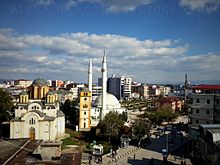Religion in Kosovo
| Part of a series on the |
| Culture of Kosovo |
|---|
 |
| History |
|
People |
|
Languages |
|
Mythology and folklore |
| Cuisine |
| Festivals |
| Religion |
|
Art |
| Literature |
| Music |
| Sport |
| Monuments |

Religion in Kosovo is separated from the state.[1] The Constitution establishes Kosovo[a] as a secular state that is neutral in matters of religious beliefs and where everyone is equal before the law and freedom to belief, conscience and religion is guaranteed.
Statistics

According to the
According to Pew Research Center's 2015 study, in 2010 Kosovo had 97.5% Muslims and 2.1% Christians; all other religious groups and the unaffiliated each had less than 1%.[3]
Religion in Kosovo (European Social Survey 2012) [4]
According to the European Social Survey in 2012, the population of Kosovo was 97.5% Muslim, 0.1% Catholic, 2.1% Eastern Orthodox and 0.3% irreligious.[4]
The 2011 Kosovo population census was largely boycotted by the
The results of the 2011 census gave the following religious affiliations for the population included in the census:[8]
Almost all Muslims in Kosovo are Sunni Muslims. The majority of Roma Muslims belong to Sufi brotherhoods, a sizeable number of practising Albanian Muslims also.[9]
The Serb population is largely
History
Christianity

Christianity probably reached Kosovo in the 5th century as the Roman Empire gradually split into a Greek East and Latin West. Kosovo became part the former, known as the Byzantine Empire, and thus fell into the sphere of the Eastern Orthodox Church based in Constantinople.[10] During the High Middle Ages, as Byzantine rule in Kosovo gave way to the Serbian Empire in the early 13th century, there was an Orthodox Christian majority, but also a Catholic minority consisting of the Italo-Dalmatian merchant class from Ragusa, German immigrants from Hungary and Transylvania, and probably all of the native Albanian population.[10]
Serbian Orthodoxy
The presence of Serbian Orthodox bishops in Lipjan and Prizren was first recorded in the 10th century.[11] In 1219, the Serbian Orthodox Church split from the Greek Orthodox Church, and Greek bishops were expelled from Kosovo.[11] The See of the Serbian Orthodox Church was moved from Žiča in present-day Serbia to Peja in present-day Kosovo in 1252, thus making it the religious and cultural centre of Serbian Orthodoxy. In 1346, the archbishop of Peja assumed the title of patriarch.[11]
Catholicism and crypto-Catholics
Kosovo was conquered by the
Protestantism
Islam

After victory at the
Freedom of religion
In 2023, the country was scored 2 out of 4 for religious freedom.[21]
See also
- Christianity in Kosovo
- Catholic Church in Kosovo
- History of the Jews in Kosovo
- Serbian Orthodox Church in Kosovo
- Islam in Kosovo
- Destruction of Albanian heritage in Kosovo
- Destruction of Serbian heritage in Kosovo
References
- ^ "Kosovo". Freedom of Thought Report 2017. International Humanist and Ethical Union. 4 December 2017. Retrieved 16 December 2017.
- ^ a b c "Serbia (includes Kosovo)". International Religious Freedom Report 2017. U.S. Department of State. 2007. Retrieved 18 December 2017.
- ^ "Religions in Kosovo". Global Religious Futures Project. Pew-Templeton. 2 April 2015. Retrieved 17 December 2017.
- ^ a b "SMRE". www.smre-data.ch. Retrieved 2023-01-15.
- ^ Petrit Collaku (29 March 2011). "Kosovo Census to Start Without the North". Balkan Insight. Retrieved 17 December 2017.
- ^ Perparim Isufi (14 September 2017). "Kosovo Police Stop 'Illegal' Serb Census Attempts". Balkan Insight. Retrieved 17 December 2017.
- ^ "KOSOVO 2017 INTERNATIONAL RELIGIOUS FREEDOM REPORT" (PDF). p. 2. Archived from the original (PDF) on 2018-05-29.
- ^ "Kosovo Population and Housing Census 2011 - Final Results: Quality Report". unstats.un.org. United Nations Statistics Division. 2011. Retrieved 17 December 2017.
- ^ "The influence of Sufi Islam in the Balkans". Euobserver.com. December 2010. Retrieved 2017-08-29.
- ^ a b Elsie (2015), p. 60–61.
- ^ ISBN 9780810874831.
- ^ Encarta-encyclopedie Winkler Prins (1993–2002) s.v. "Albanië. §6. Geschiedenis". Microsoft Corporation/Het Spectrum.
- ISBN 978-1-85065-431-5.
- ^ Duijzings 2000, p. 92.
- ^ Duijzings 2000, p. 93.
- ^ Duijzings 2000, p. 94.
- ^ Duijzings 2000, p. 96.
- ^ Duijzings 2000, p. 99.
- ^ Malcolm, Noel, Kosovo: A Short History, pp. 105-108
- ^ a b Elsie (2015), p. 130.
- ^ Freedom House website, Kosovo website, retrieved 2023-08-08
